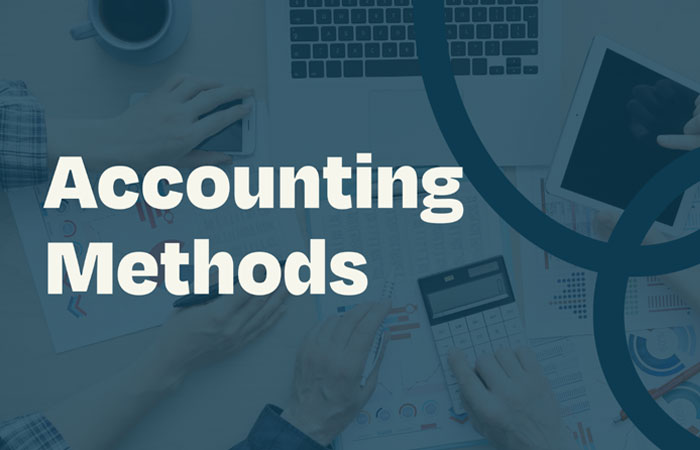
What Does an Accountant Do For Your Taxes?
February 5, 2025
Tax Extension Does Not Equal an Extension to Pay
March 3, 2025When it comes to preparing your taxes, understanding the accounting methods available to you is crucial. The way you record your income and expenses can have a significant impact on how much you owe in taxes and when you owe it. The IRS allows businesses and individuals to choose from several accounting methods, each with its own set of rules and implications. Let’s take a closer look at the most common accounting methods for taxes and how they work.
1. Cash Basis Accounting
The cash basis accounting method is one of the simplest and most commonly used accounting methods, especially for small businesses and sole proprietors. Under this method, income is recorded when it’s received, and expenses are recorded when they’re paid. This means that you only recognize income and expenses when actual cash changes hands, rather than when transactions occur.
For example, if you invoice a client in December but don’t receive the payment until January, you wouldn’t report that income until the payment is received in January. Similarly, if you purchase office supplies in December but don’t pay for them until January, you wouldn’t deduct the expense until January.
Advantages of Cash Basis Accounting:
- Simplicity: It’s easy to track income and expenses since you’re only concerned with actual cash flows.
- Tax deferral: If you delay income or expenses until the following year, you can push your tax obligations to the future.
Disadvantages of Cash Basis Accounting:
- Less accurate for businesses that carry inventory or offer credit, since it doesn’t reflect the true financial position of the business at a given time.
2. Accrual Basis Accounting
The accrual basis accounting method is more complex than cash basis accounting but offers a more accurate picture of your business’s financial health. Under this method, income is recognized when it’s earned, and expenses are recognized when they are incurred, regardless of when cash is actually received or paid.
For instance, if you provide a service in December and invoice the client, you would report the income in December, even if the client doesn’t pay until January. Similarly, if you incur an expense in December(such as receiving an invoice for office supplies), you would recognize the expense in December, even if you don’t pay the bill until January.
Advantages of Accrual Basis Accounting:
- More accurate financial picture: This method aligns your revenue and expenses with the period they were earned or incurred, giving a more realistic view of your financial situation.
- Required for larger businesses: Businesses with inventory or those making over $25 million in annual sales must use accrual accounting, according to IRS guidelines.
Disadvantages of Accrual Basis Accounting:
- Complexity: Accrual accounting requires more detailed tracking of transactions and may involve additional paperwork.
- Can create timing issues: Since you may have to pay taxes on income you haven’t yet received, it can result in cash flow issues for some businesses.
3. Hybrid Accounting Method
The hybrid accounting method is a combination of both cash and accrual methods. Typically, businesses using the hybrid method will apply accrual accounting for income and expenses related to inventory but use cash basis accounting for other items, like general operating expenses. This method can offer a balance between simplicity and accuracy, depending on the nature of the business.
For example, a retailer might use accrual accounting for inventory purchases and sales (since inventory is crucial for accurate reporting) but use cash basis accounting for other operating expenses like rent and utilities.
Advantages of Hybrid Accounting Method:
- Flexibility: Allows businesses to choose the method that best fits different aspects of their operations.
- Can be easier to manage than full accrual accounting, especially for smaller businesses.
Disadvantages of Hybrid Accounting Method:
- Can be confusing to implement: Properly separating transactions into cash and accrual categories can require careful tracking and judgment.
- May not be allowed in all situations: The IRS has specific guidelines about which businesses can use this method.
4. Completed Contract Method
The completed contract method is an accounting method typically used by contractors or businesses involved in long-term projects. Under this method, revenue and expenses are recognized only when the project is completed. This can be beneficial for businesses where work spans multiple years, like construction or large-scale projects.
Advantages of Completed Contract Method:
- Simplicity: Revenue and expenses are recognized when the contract is finished, making it easier to match costs with income.
- Delayed tax liability: You can defer recognizing income and expenses until the project is completed, which can help with cash flow management.
Disadvantages of Completed Contract Method:
- Not suitable for all businesses: This method is mainly used for long-term projects and may not be appropriate for businesses with shorter-term contracts or retail operations.
Choosing the right accounting method for your taxes is essential for managing your business’s financial health and ensuring you comply with IRS regulations. The cash basis method is straightforward and useful for smaller businesses, while the accrual method provides a more accurate picture of your financial situation. The hybrid method offers a mix of both, and the completed contract method is ideal for long-term projects. Each method has its own advantages and drawbacks, so it’s important to consult with an accountant or tax professional to determine the best approach for your unique circumstances.




